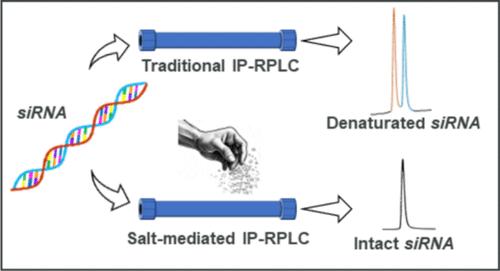当前位置:
X-MOL 学术
›
Anal. Chem.
›
论文详情
Our official English website, www.x-mol.net, welcomes your
feedback! (Note: you will need to create a separate account there.)
Expanding the Analytical Toolbox for the Nondenaturing Analysis of siRNAs with Salt-Mediated Ion-Pair Reversed-Phase Liquid Chromatography
Analytical Chemistry ( IF 6.7 ) Pub Date : 2024-11-11 , DOI: 10.1021/acs.analchem.4c05248 Martin Enmark, Ilaria Furlan, Porya Habibollahi, Christian Manz, Torgny Fornstedt, Jörgen Samuelsson, Eivor Örnskov, Manasses Jora
Analytical Chemistry ( IF 6.7 ) Pub Date : 2024-11-11 , DOI: 10.1021/acs.analchem.4c05248 Martin Enmark, Ilaria Furlan, Porya Habibollahi, Christian Manz, Torgny Fornstedt, Jörgen Samuelsson, Eivor Örnskov, Manasses Jora

|
Short interfering RNA (siRNA) represents a rapidly expanding class of marketed oligonucleotide therapeutics. Due to its double-stranded nature, the characterization of siRNA is twofold: (i) at the single-strand (denaturing) level for impurity profiling and (ii) at the intact (nondenaturing) level to confirm duplex formation and quantify excess single strands (including single strand-derived impurities). While denaturing analysis can be carried out using conventional ion-pair reversed-phase liquid chromatography (IP-RPLC), nondenaturing characterization of siRNA is a significantly less straightforward task. Typical IP-RPLC conditions have an intrinsic denaturing effect on siRNA, thereby limiting the development of viable approaches for the intact duplex analysis. In this study, we demonstrate, through the design of experiments of siRNA melting temperatures and chromatography analyses, that the simple addition of salts, such as phosphate-buffered saline and ammonium acetate, to eluents enhances the suitability of IP-RPLC for the nondenaturing analysis of siRNA during both UV- and mass spectrometry-based analysis. This work represents a milestone in overcoming the challenges associated with nondenaturing analysis of siRNAs by IP-RPLC and offers a fresh angle for exploring IP-RPLC of siRNAs.
中文翻译:

扩展使用盐介导的离子对反相液相色谱法对 siRNA 进行非变性分析的分析工具箱
短干扰 RNA (siRNA) 代表了一类迅速扩展的市售寡核苷酸治疗药物。由于其双链性质,siRNA 的表征分为两方面:(i) 在单链(变性)水平上用于杂质分析,以及 (ii) 在完整(非变性)水平上用于确认双链体形成并定量过量的单链(包括单链衍生的杂质)。虽然可以使用传统的离子对反相液相色谱 (IP-RPLC) 进行变性分析,但 siRNA 的非变性表征是一项明显不那么简单的任务。典型的 IP-RPLC 条件对 siRNA 具有内在的变性作用,从而限制了完整双链体分析的可行方法的开发。在本研究中,我们通过 siRNA 熔解温度和色谱分析的实验设计证明,在洗脱液中简单地添加盐(如磷酸盐缓冲盐水和乙酸铵)可增强 IP-RPLC 在基于 UV 和质谱分析中对 siRNA 非变性分析的适用性。这项工作是克服 IP-RPLC 对 siRNA 进行非变性分析相关挑战的里程碑,并为探索 siRNA 的 IP-RPLC 提供了一个新的角度。
更新日期:2024-11-11
中文翻译:

扩展使用盐介导的离子对反相液相色谱法对 siRNA 进行非变性分析的分析工具箱
短干扰 RNA (siRNA) 代表了一类迅速扩展的市售寡核苷酸治疗药物。由于其双链性质,siRNA 的表征分为两方面:(i) 在单链(变性)水平上用于杂质分析,以及 (ii) 在完整(非变性)水平上用于确认双链体形成并定量过量的单链(包括单链衍生的杂质)。虽然可以使用传统的离子对反相液相色谱 (IP-RPLC) 进行变性分析,但 siRNA 的非变性表征是一项明显不那么简单的任务。典型的 IP-RPLC 条件对 siRNA 具有内在的变性作用,从而限制了完整双链体分析的可行方法的开发。在本研究中,我们通过 siRNA 熔解温度和色谱分析的实验设计证明,在洗脱液中简单地添加盐(如磷酸盐缓冲盐水和乙酸铵)可增强 IP-RPLC 在基于 UV 和质谱分析中对 siRNA 非变性分析的适用性。这项工作是克服 IP-RPLC 对 siRNA 进行非变性分析相关挑战的里程碑,并为探索 siRNA 的 IP-RPLC 提供了一个新的角度。

































 京公网安备 11010802027423号
京公网安备 11010802027423号